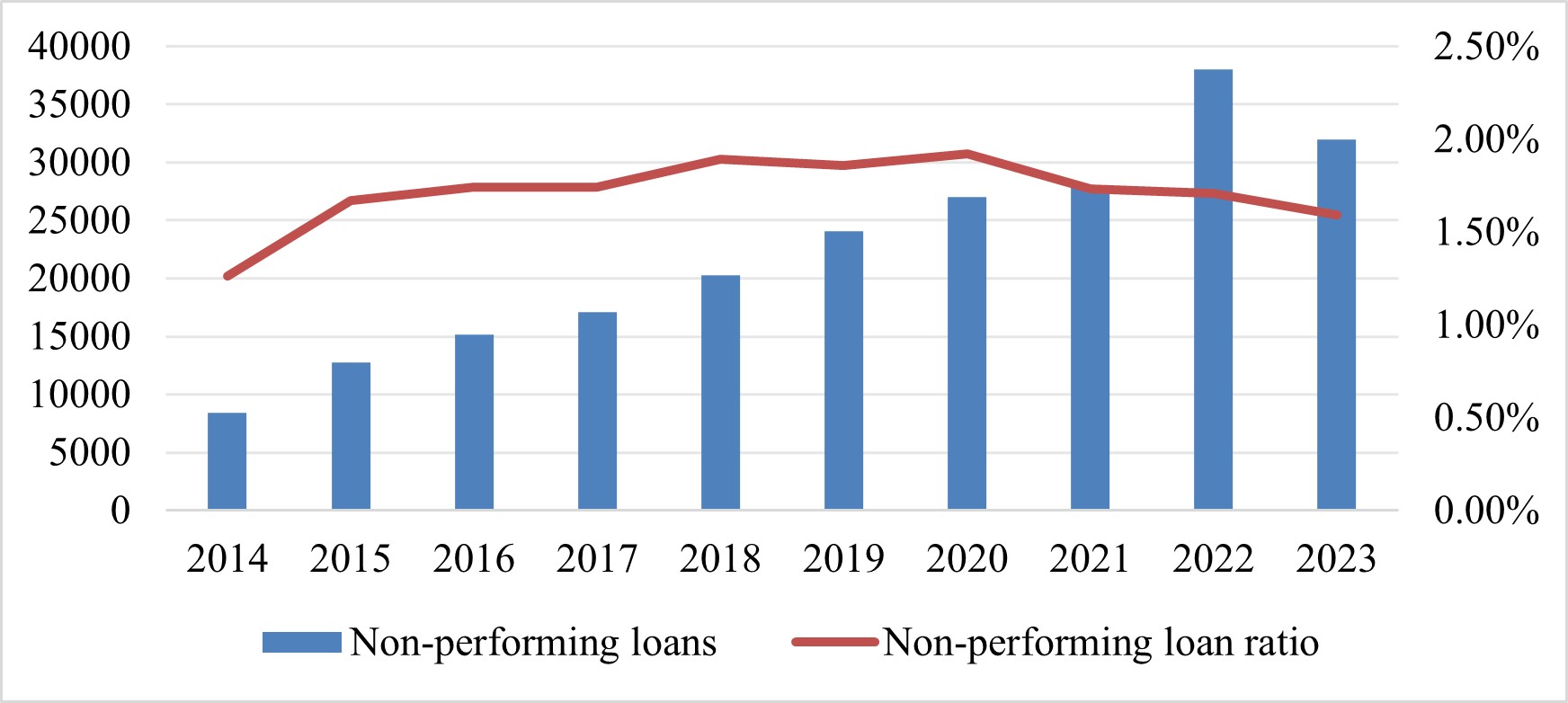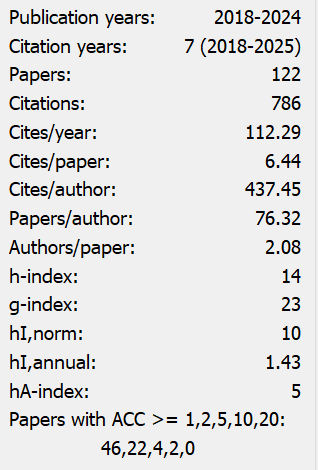Impact of the Real Estate Climate Index on the Non-performing Loan Ratio of Commercial Banks
Abstract
The 20th National Congress of the Communist Party of China emphasized the imperative to enhance the financial stability safeguard system. Given the pivotal role of commercial banks in China’s financial architecture, effectively managing their non-performing loan ratio proves crucial for sustaining financial and economic stability. This study uses panel data from 2007 to 2022 for empirical analysis. It explores the significant positive link between the real estate climate index and the non - performing loan ratio of commercial banks, showing that the real estate boom worsens systemic credit risk.Heterogeneity analysis reveals this effect manifests more prominently in state-owned commercial banks. Furthermore, capital regulation has a mitigating effect on the positive relationship between the index and the ratio of non-performing loans.These empirical findings highlight the importance of targeted regulatory measures and enhanced real estate market monitoring, providing theoretical and policy insights for optimizing financial risk governance frameworks.
References
[2] Barthet. (1999). Banking systems around the globe: Do regulation and ownership affect performance and stability? Brookings-Wharton Papers on Financial Services, 6(1), 1–67.
[3] Wang, X. (2011). Research on corporate governance structure and operating performance of commercial banks. Business Research, 12(416), 95–99.
[4] Wu, Q. (2021). Analysis on the disposal methods of non-performing loans in commercial banks. Commercial Banks, 37(6), 54–58.
[5] Tao, C. (2005). Banking crisis: Analysis from the perspective of financial bubble. Financial Forum, 10(6), 66–73.
[6] Ding, X. (2023). Government supervision, market constraints and bank risk taking. Financial Economics Research, 38(4), 143–160.
[7] Zhang, H. (2010). Real estate credit and real estate price changes. Productivity Research, 26(8), 71–72.
[8] Zhou, X. (2012). Research on real estate economic fluctuations based on national housing prosperity index and its impact on credit risk. Construction Economy, 33(4), 76–78.
[9] Gao, H., & Zhao, J. (2009). Formation and development of non-performing loans in China's banking industry: An applied study based on economic transformation. Jilin: Jilin Publishing Group Co., Ltd.
[10] Jin, Y. (2017). Analysis of changes in loan quality of commercial banks in China based on major listed banks. Commercial Banks, 33(10), 82–85. https://doi.org/10.1016/j.cjar.2016.12.001
[11] Ohlson, J. (1980). Financial ratios and the probabilistic prediction of bankruptcy. Journal of Accounting Research, 18(1), 109–131. https://doi.org/10.2307/2490395
[12] Altman, E. I. (1995). Predicting financial distress of companies: Revisiting the Z-score and ZETA models. Journal of Credit Risk Management, 19(2), 1–25.
[13] Guo, X. (2010). Factors influencing the sustainability of profitability of listed banking companies. Financial Forum, 15(9), 31–37.
[14] Zhang, J. (2018). Measurement and influencing factors of systemic risk in China's banking sector. Economic Review, 35(5), 143–150.
[15] Berge, T. O., & Boye, K. G. (2007). An analysis of bank’s problem loans. Norges Bank Economic Bulletin, 78(3), 65–76.
[16] Louzis, D. P., Vouldis, A. T., & Metaxas, V. L. (2012). Macroeconomic and bank-specific determinants of non-performing loans in Greece: A comparative study of mortgage, business and consumer loan portfolios. Journal of Banking and Finance, 36(4), 1012–1027. https://doi.org/10.1016/j.jbankfin.2011.10.012
[17] Zou, K. (2017). Empirical analysis of factors affecting non-performing loan ratio: Based on provincial panel data from 2005 to 2014. Financial Theory and Practice, 39(2), 10–18.
[18] Shin, H., & Kolari, J. W. (2016). Efficiency in Japanese banking: An empirical analysis. Journal of Banking & Finance, 68(8), 11–14.
[19] Zhang, L., & Han, L. (2016). The impact of mixed ownership on the non-performing loan ratio of Chinese listed banks. International Finance Research, 32(7), 50–61.
[20] Liu, Y. (2014). Analysis of causes and related factors of non-performing loans of commercial banks in China. Systems Engineering, 32(5), 65–74.
[21] Su, S. (2024). Empirical analysis of the influencing factors of non-performing loan ratio of China’s commercial banks. Business Exhibition Economy, 6(20), 109–113.
[22] Zhang, H. (2012). Analysis of the dynamic relationship between economic leading index and China’s macroeconomic growth. Economic Issues, 34(11), 9–12.
[23] Hu, T., Wang, H., & Qiu, W. (2016). The linkage between China’s national housing prosperity index and macroeconomic prosperity index: An empirical study based on VAR model. Journal of Hubei University of Science and Technology, 36(12), 30–34.
[24] Xiao, Q. (2025). A study on the bidirectional risk spillover effect between China’s stock market and housing market: Analysis based on time-varying Copula-CoVaR model. Journal of Shandong University of Finance and Economics, 37(1), 58–101.
[25] Liu, Y. (2020). The impact of real estate market fluctuations on the capital layout of real estate enterprises: Based on the perspective of financial analysis. Economic Forum, 62(6), 120–126.
[26] Hofmann, B. (2003). Bank lending and property prices: Some international evidence. HKIMR Working Paper, 12(1), 1–38. https://doi.org/10.2139/ssrn.1009079
[27] Kindleberger, C. P. (1978). Manias, panics and crashes: A history of financial crises. New York: Basic Books. https://doi.org/10.1007/978-1-349-04338-5
[28] Wang, H., & Gao, G. (2013). Evaluation of the dependence of commercial banks on real estate industry. The Banker, 14(2), 74–76.
[29] Shao, D. (2005). Closely monitor the guarantee risk in commercial bank loan business. China Finance, 55(21), 69.
[30] Mou, L. (2013). Research on the correlation between credit growth and real estate market risk. Accounting Friends, 29(1), 78–80.
[31] Liu, X., & Wang, Y. (2018). The impact of excessive real estate market prosperity on financial expansion. Southern Finance, 40(2), 3–11.
[32] Jia, Y., Liu, Y., & Peng, J. (2024). A review of research on identification, causes, prevention and resolution of real estate financial risks. Real Estate Economy, 45(3), 1–15.
[33] Chen, R. (2000). Risk assessment and avoidance strategies of personal housing mortgage loans in commercial banks. Economic Management, 22(6), 45–52.
[34] Sun, T. (2019). Real estate financial risks are concentrated in which areas? Leverage model, illegal loans of property speculators. China Economic Weekly, 19(5), 18–22.
[35] Han, F. (2022). Characteristics, potential risks and development direction of China's real estate finance system. Future and Development, 1(1), 11–15.
[36] Xu, J. (2025). Dominant role and risk analysis of state-owned commercial banks in serving the real economy. Investment and Entrepreneurship, 2(1), 176–178.
[37] Xu, Y., & Liu, H. (2019). Government's risk tolerance to the state-owned banking system and its implicit rescue pressure. Economic Research, 54(1), 64–75.
[38] Wei, Q. (2020). Research on the influence of bank property rights structure on loan efficiency. Economic Forum, 38(8), 42–52.
[39] Wang, Z. (2025). Will digital transformation expand the credit risk of commercial banks? Jianghan Forum, 67(1), 37–44.
[40] Chen, T. (2021). Economic policy uncertainty, asset prices and bank credit risk: The moderating effect of capital regulation. Journal of Yunnan University of Finance and Economics, 37(10), 37–54.
[41] Ma, L., Chen, R., Li, J., & Jiang, N. (2021). Research on the impact of real estate loans on the risk of commercial banks. Financial Supervision Research, 9(1), 12–28.
[42] Qiu, Z., & Wang, T. (2009). Research on China's real estate economic cycle 1950–2008. Economic Research Reference, 39(71), 1–12.
[43] Cui, R., Chen, W., & Liu, M. (2023). The impact of housing price fluctuation on commercial banks' risk exposure. Financial Theory and Practice, 45(3), 88–95.
[44] Wang, H. (2017). Financialization of real enterprises promotes or inhibits enterprise innovation. Economic and Trade Practice, 18(23), 45–55.


This work is licensed under a Creative Commons Attribution 4.0 International License.
Copyright for this article is retained by the author(s), with first publication rights granted to the journal.
This is an open-access article distributed under the terms and conditions of the Creative Commons Attribution license (http://creativecommons.org/licenses/by/4.0/).


























